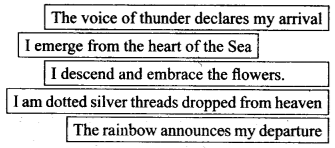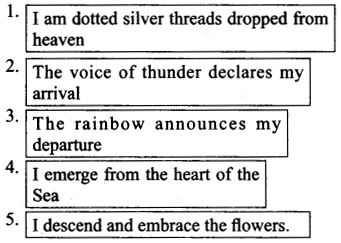Question 1.
(a) Given below are five lines from a poem but they are not in the right order.
Get into groups of four. Read the lines and put them in the right order. Read the version that you develop to the whole class:

(b) What is ‘I’ in these lines?
(c) Imagining yourself as the subject of this poem, write five lines about yourself in less than five minutes.
You may like to
— define yourself
— state what you do
— explain why people like/dislike you
— mention any other characteristic about yourself
Answer:
(a)

(b) ‘I’ stands for the rain.
(c) For self-study.
Question 2.
Now listen to a poem about the rain. As you
listen number the stanzas given in the boxes.
Answer:
For self-attempt.
Question 3.
Read the poem on Page 90.
Answer:
For self-attempt.
Question 4.
On the basis of your understanding of the poem, answer the following questions by ticking the correct choice.
(?) The rain calls itself the ‘‘dotted silver threads’ as ______
- (i) the shimmering drops fall one after the other
- (ii) it ties heaven and earth
- (iii) it dots the earth with shimmering water
- (iv) it decorates the fields
Answer:
(i) the shimmering drops fall one after the other
(b) The tone and mood of the rain in the poem reflect its ______
(i) love for the earth
(ii) desire to take revenge
(iii) merriment as it destroys
(iv) desire to look beautiful
Answer:
(i) love for the earth
Question 5.
Answer the following questions:
(?) Why is the rain divine?
(b) In this universe, rain performs many functions. What are those?
(c) “When / cry the hills laugh;
When I humble myself the flowers rejoice;
When I bow, all things are elated. ”
Cry, humble and bow indicate different intensity with which the rain falls. Explain the three in context.
(d) How do you think the rain quenches the thirst of the fields and cures clouds’s ailment?
(e) Think about million little ways in which the rain embraces the trees. Mention a few of them.
(f) “…All can hear, but only The sensitive can understand”
What does the poet want to convey?
(g)
- Notice the imagery built around ‘sigh of the sea*, daughter of the field* and dears of heaven ’. Explain the three expressions in context of rain.
- How would you express rain as
– an agent of floods?
– a source of water for dams?
(h) “I am like earthly life… ”
Why does the poet call rain as earthly life?
(i) Explain the ending of the song.
Answer:
(a) The rain appears to be divine because it comes down from heaven. The shimmering drops of rain look like silver threads dropped from heaven. Moreover, it is a life-giving force that elates and smiles all—flowers, fields and valleys.
(b) In the universe the rain performs many functions. It is sent by Nature to adorn its fields apd valleys and gardens. Hills laugh, flowers rejoice and all are elated when it rains. The rain quenches the thirst of fields and relieves the clouds of their heaviness of vapours. It embraces flowers and trees in a million little ways.
(c) Certainly, ‘cry’, ‘humble’ and ‘bow’ indicate different intensities with which the rain falls. ‘Cry’ means full blast of the rain that makes ‘hills laugh’ as they receive a lot of rainy water. ‘Humble’ stands for mild intensity of the rain that makes flowers dance and rejoice themselves. ‘Bow’ here means a general rainfall that elates all.
(d) Naturally, when the rain falls it quenches the thirst of fields. The parched fields only wait for the rain. The rain cures the ailment of clouds. It means the clouds become heavy and want to burst out. But when it rains, they empty themselves into showers and become light again to float in the sky.
(e) The poet says that the rain embraces the trees in about million little ways. It is just a hyperbolic expression. The rain embraces the trees when the showers fall on them. The showers fall on the trees and go deep into their roots. Even rivers, lakes and drains carry rain water that reaches plants and trees.
(f) The rain has its own music. Everyone can hear the music and song of the rain. But not all can understand and feel it deeply. Only those with sensitive and delicate hearts can feel and understand the song of the rain.
(g)
- The poet has built a very suggestive imagery of rain. He uses the alliteration ‘sigh of the sea’ to express the way sea water evaporates in the form of water vapours. The rain becomes the ‘laughter’ of the field when it helps the growing crops to smile and laugh in joy. As it drops from the sky, it appears as if heaven (sky) is shedding ‘tears’ from above.
- Rain as an agent of flood:
Tears of sorrow
— Source of water for dams:
Water of life
(h) There is a similarity between earthly life and life cycle of rain. Rain’s arrival and departure is just like birth and death of earthly life. In both the cases, the end is inevitable.
(i) Kahlil Gibran ends the poem with philosophical overtones. The rain has been termed as a ‘sigh’ rising from the deep love of affection. It is like a laughter that colours the soul. It is like ‘tears’ that fall from the endless heaven of memories.
Question 6.
‘Ode to Autumn’ is a beautiful poem written by the famous poet John Keats. Listen to an excerpt from the poem and pick phrases which personify autumn. Phrases
Answer:
Phrases
______ ______
______ ______
______ ______
Answer:
personifying autumn
- (i) Thee sitting carelessly on a granary floor
- (ii) Thy hair soft-lifted by the winnowing wind
- (iii) while thy hook/Spares the next watch
- (iv) And sometimes like a gleaner thou dost keep
- (v) Steady thy laden head across a brook
- (vi) Thou watchest the last oozings hours by hours.
Question 7.
Rain in the hills and rain in the desert present entirely different scenario. In the hills it revitalises the greenery and freshens the vegetation; it waters the parched land and relieves the thirsty and panting souls in the desert.
This has been a year of scanty rains. Imagine how the rain would be welcomed when it pours in the hills and in the desert after a long dry spell. Choose one of the places and describe
- (a) What are you likely to see?
- (b) What would happen to the rain water?
- (c) What would be the scene before and after the rain?
Answer:
Raining in the Hills
- (a) The rain revitalises the greenery washing out all dust and dust particles from plants, trees and their leaves. The rain refreshes the vegetation which comes to life again with the arrival of the rain.
- (b) The rain water flows from the tops of the hills into small channels and brooks and soon takes the shape of a river.
- (c) No doubt, greenery and vegetation were there even before the rain. But its appearance was dull and dusty. After the rain, everything looks refreshed, more green and full of life.